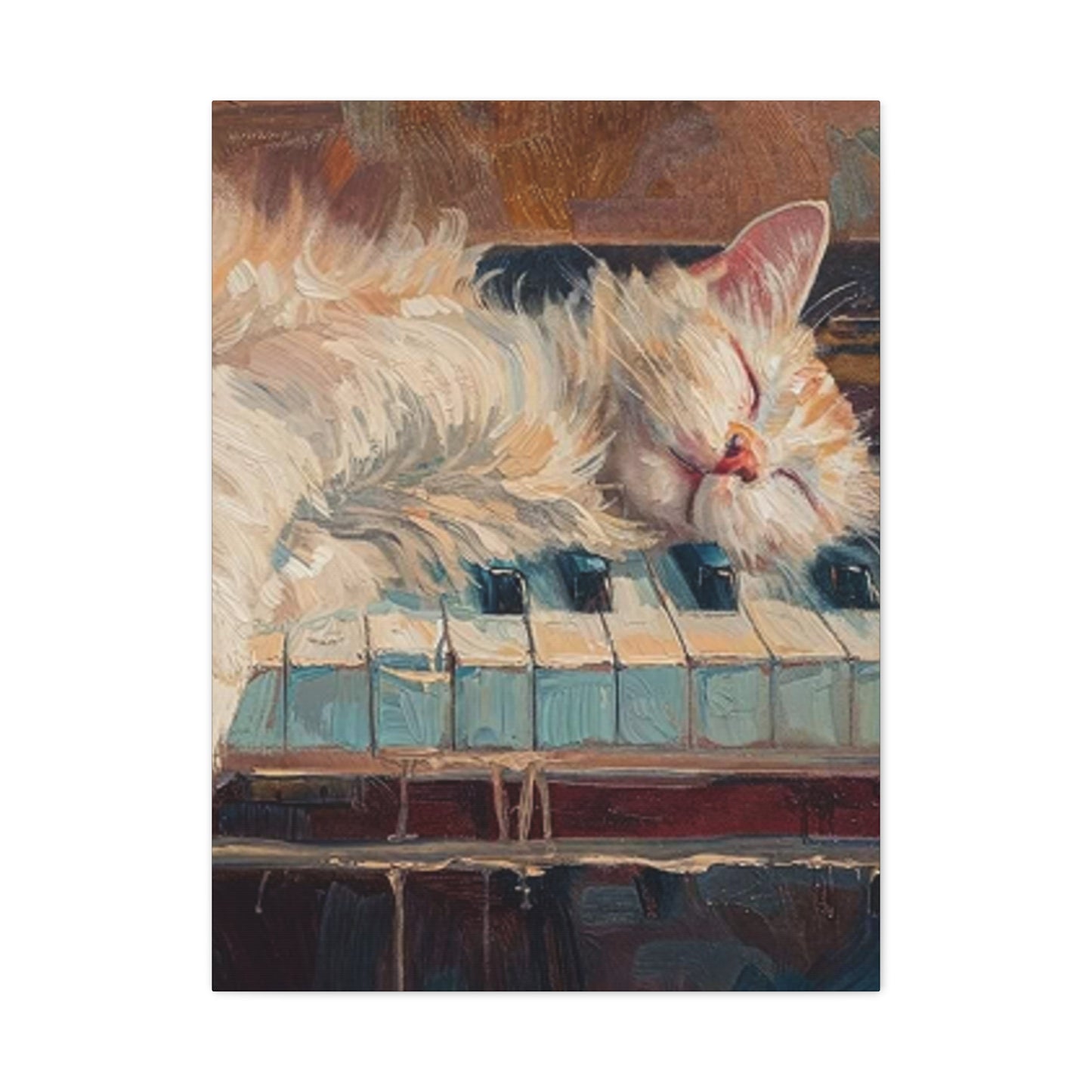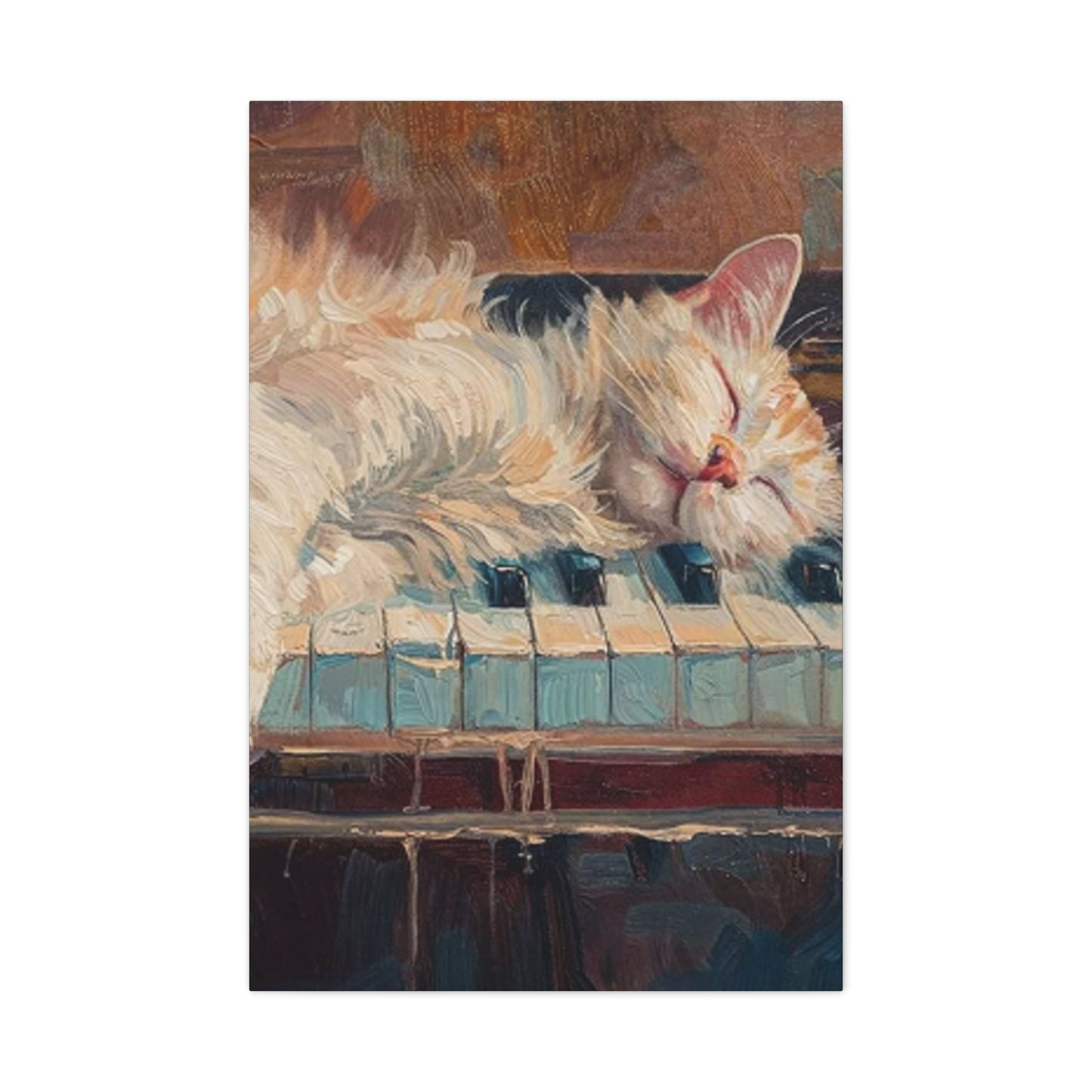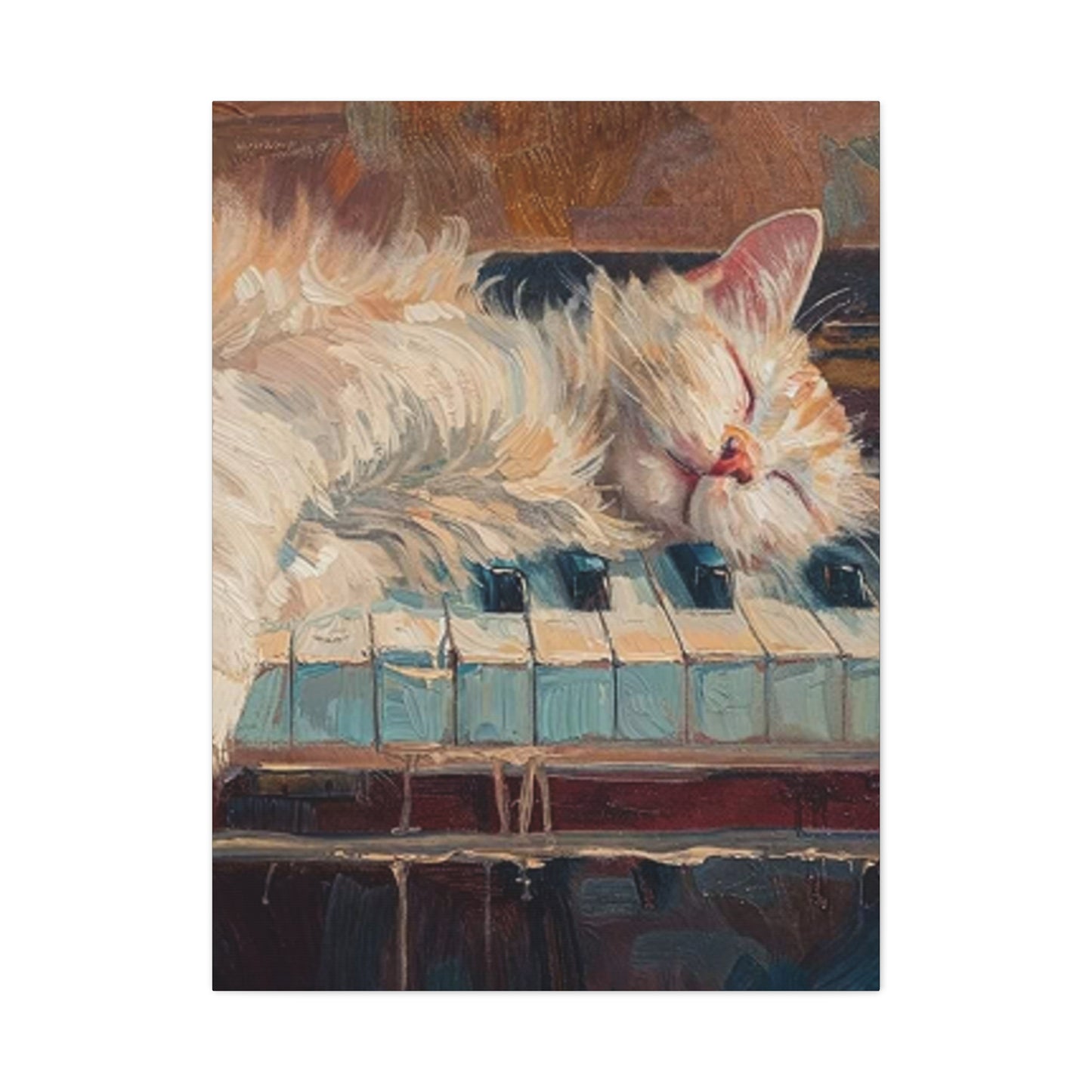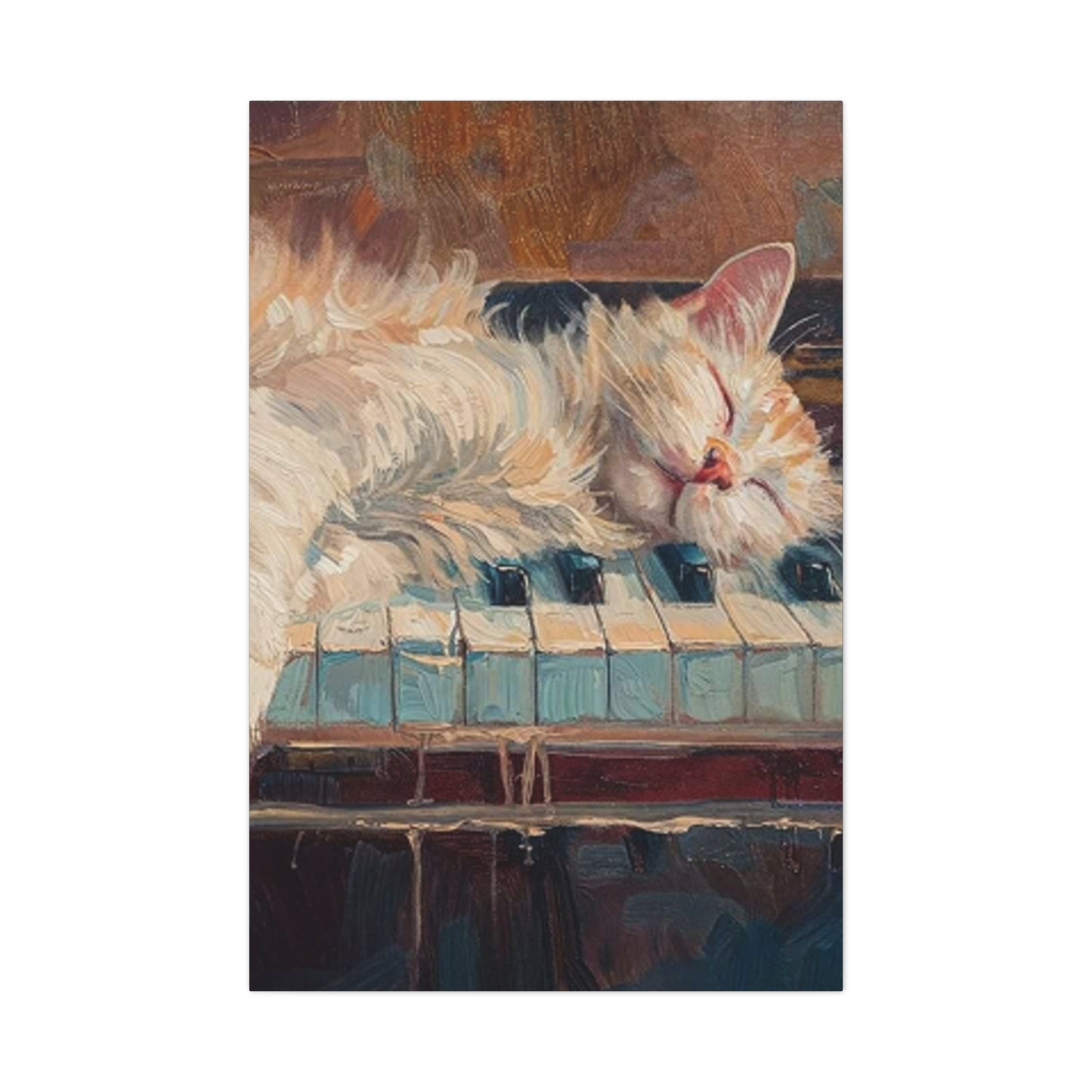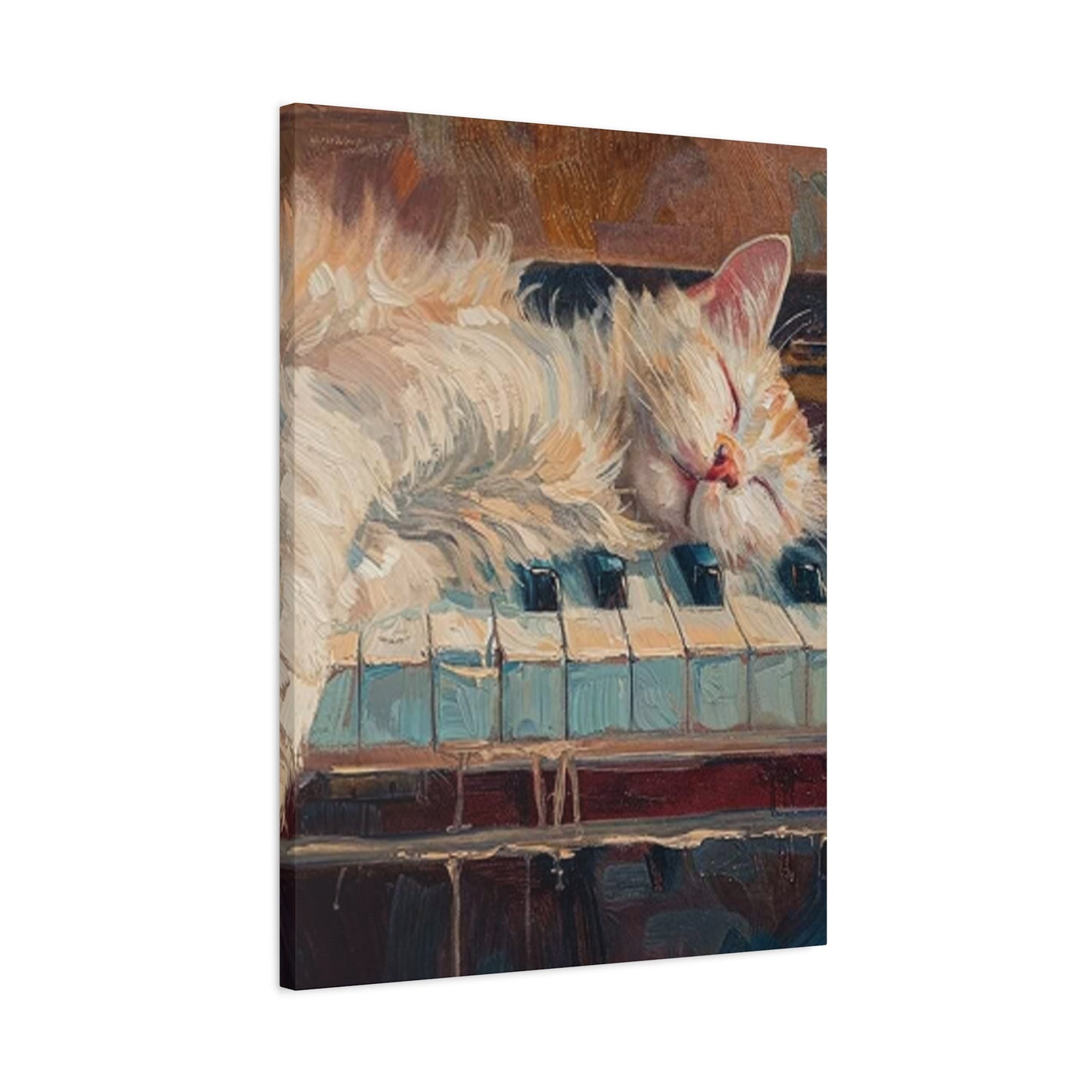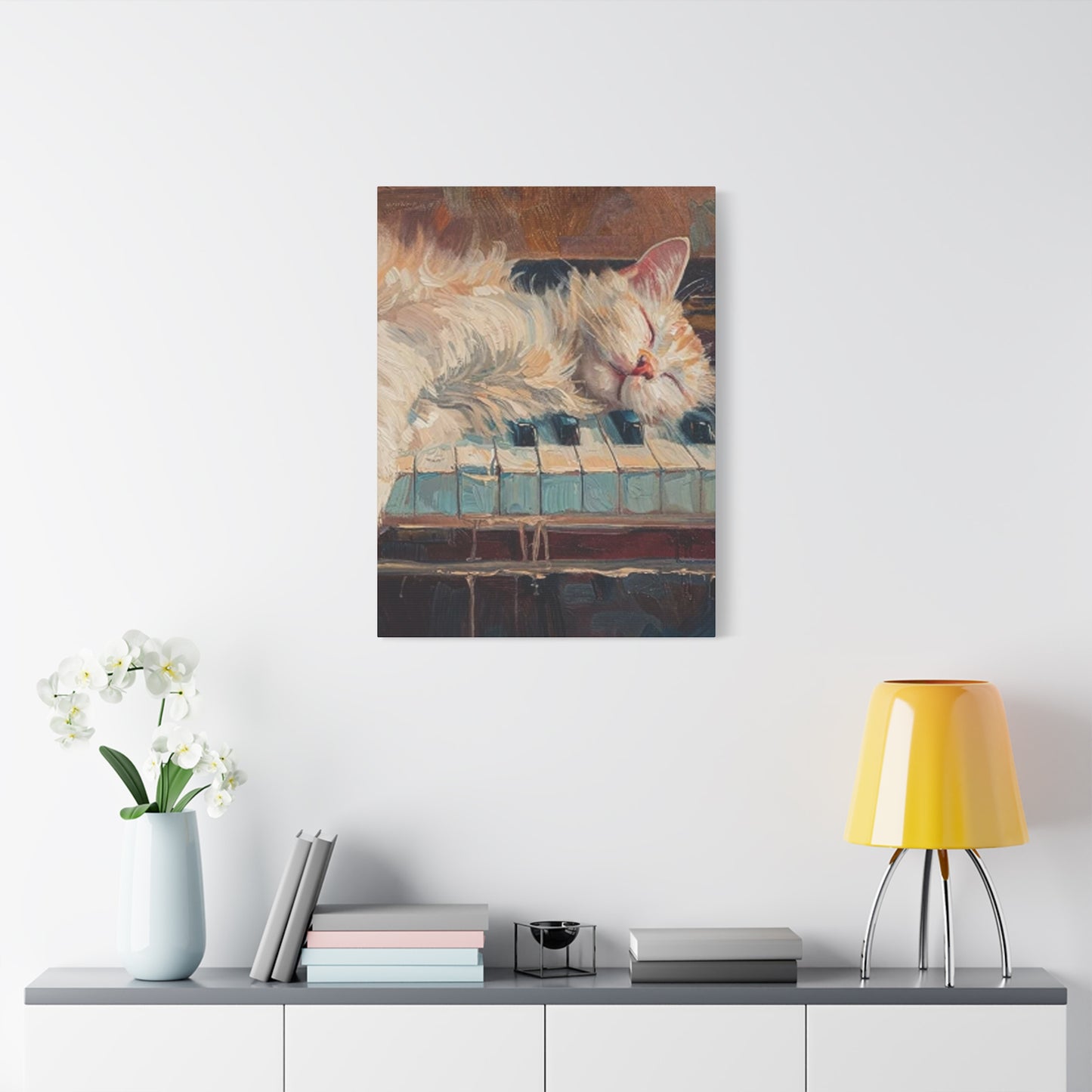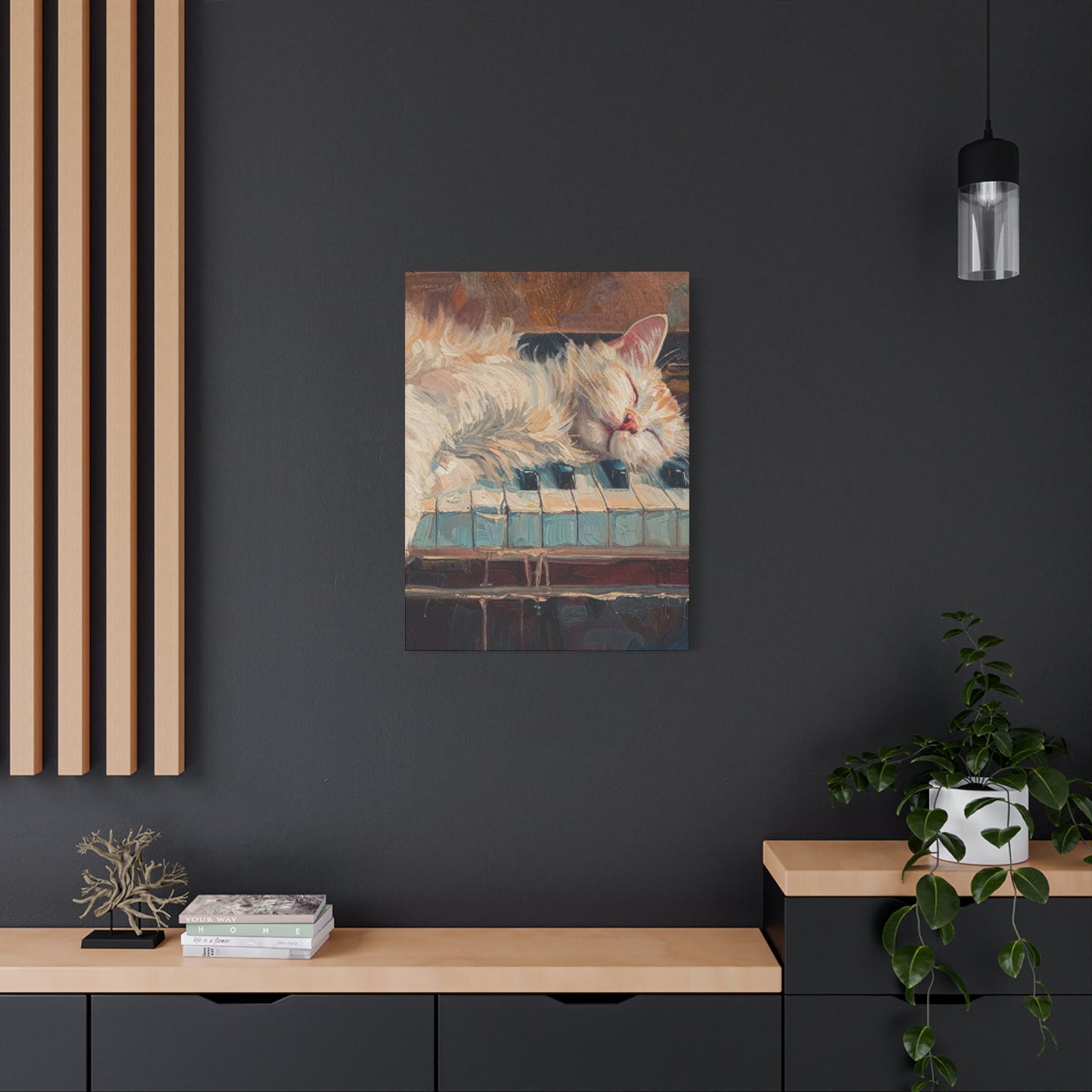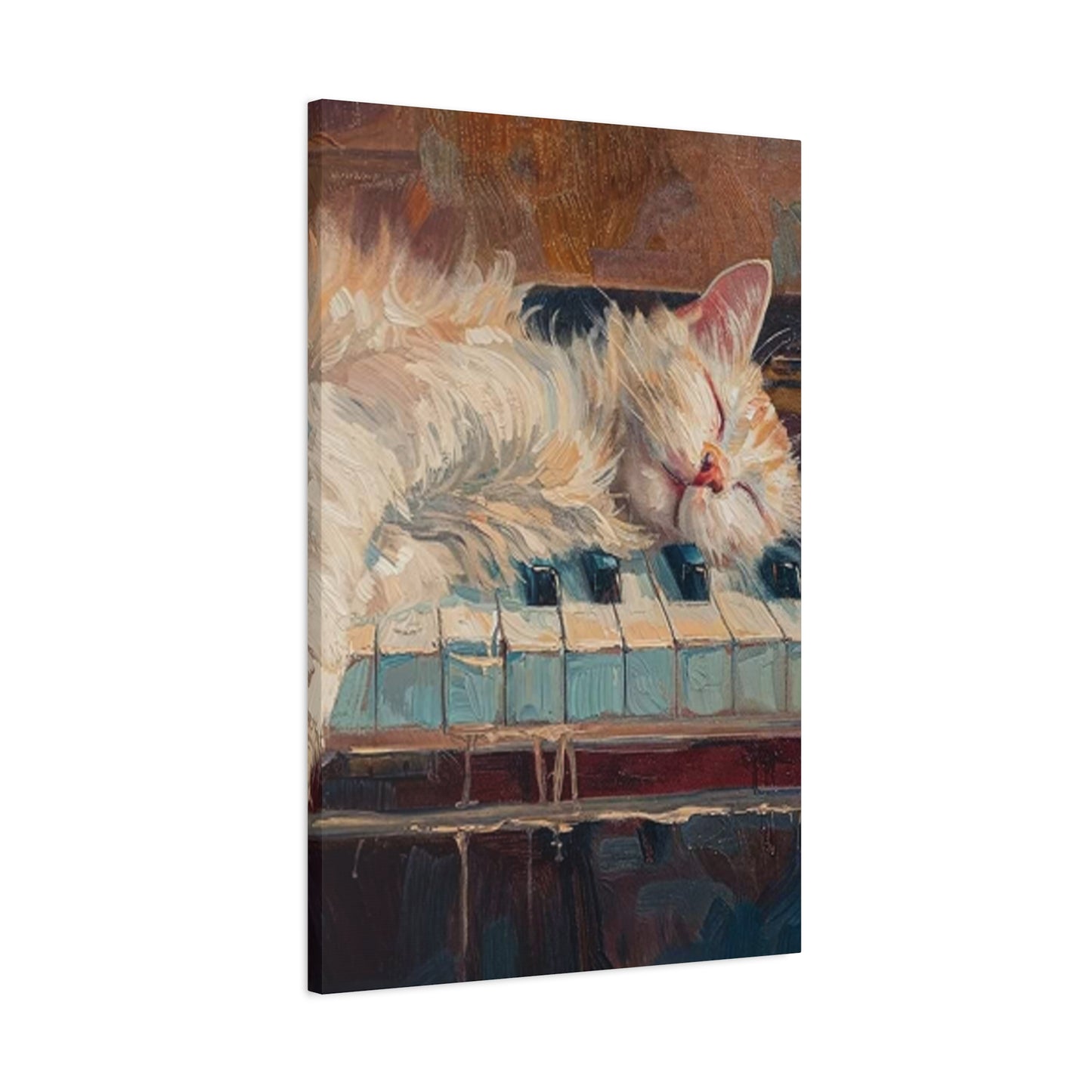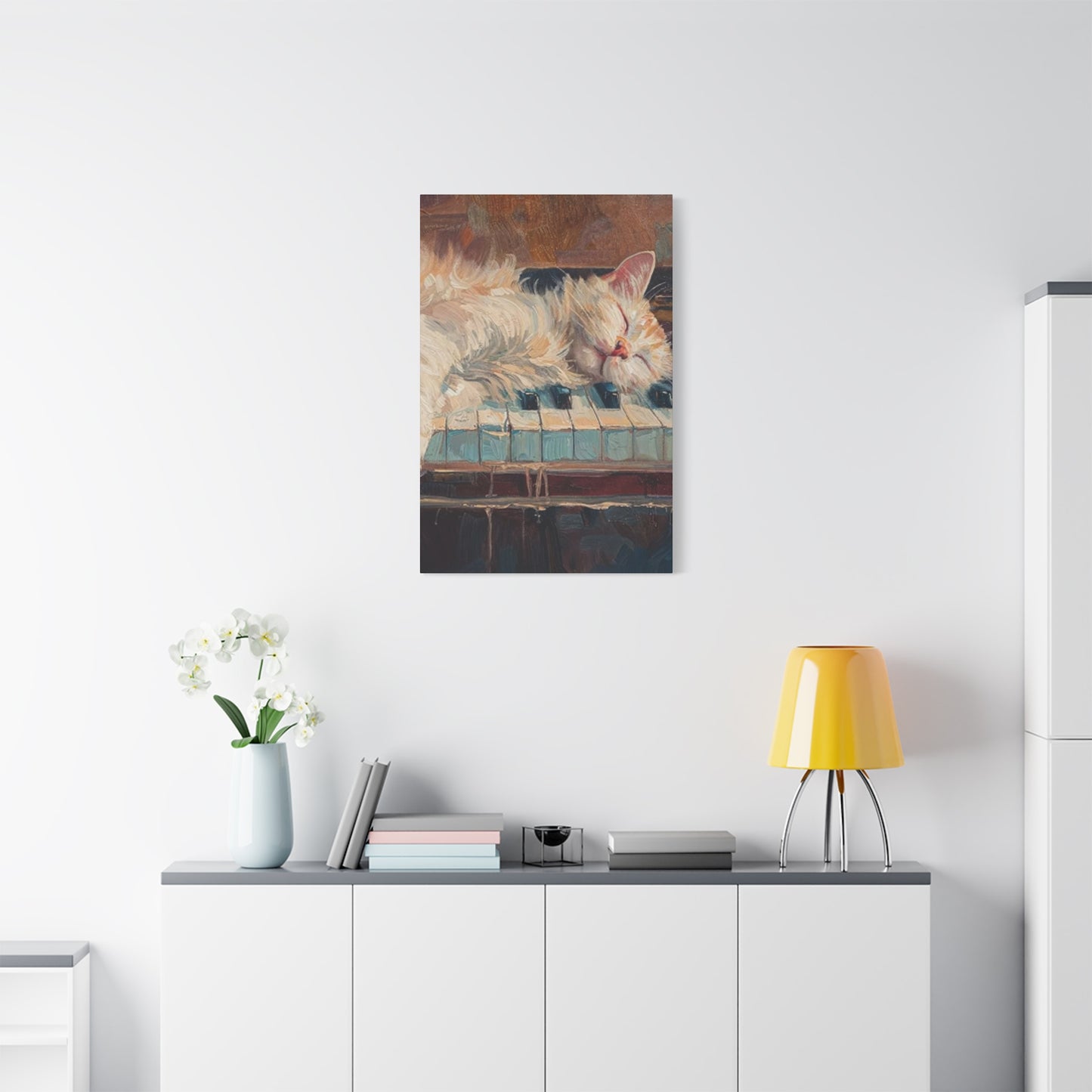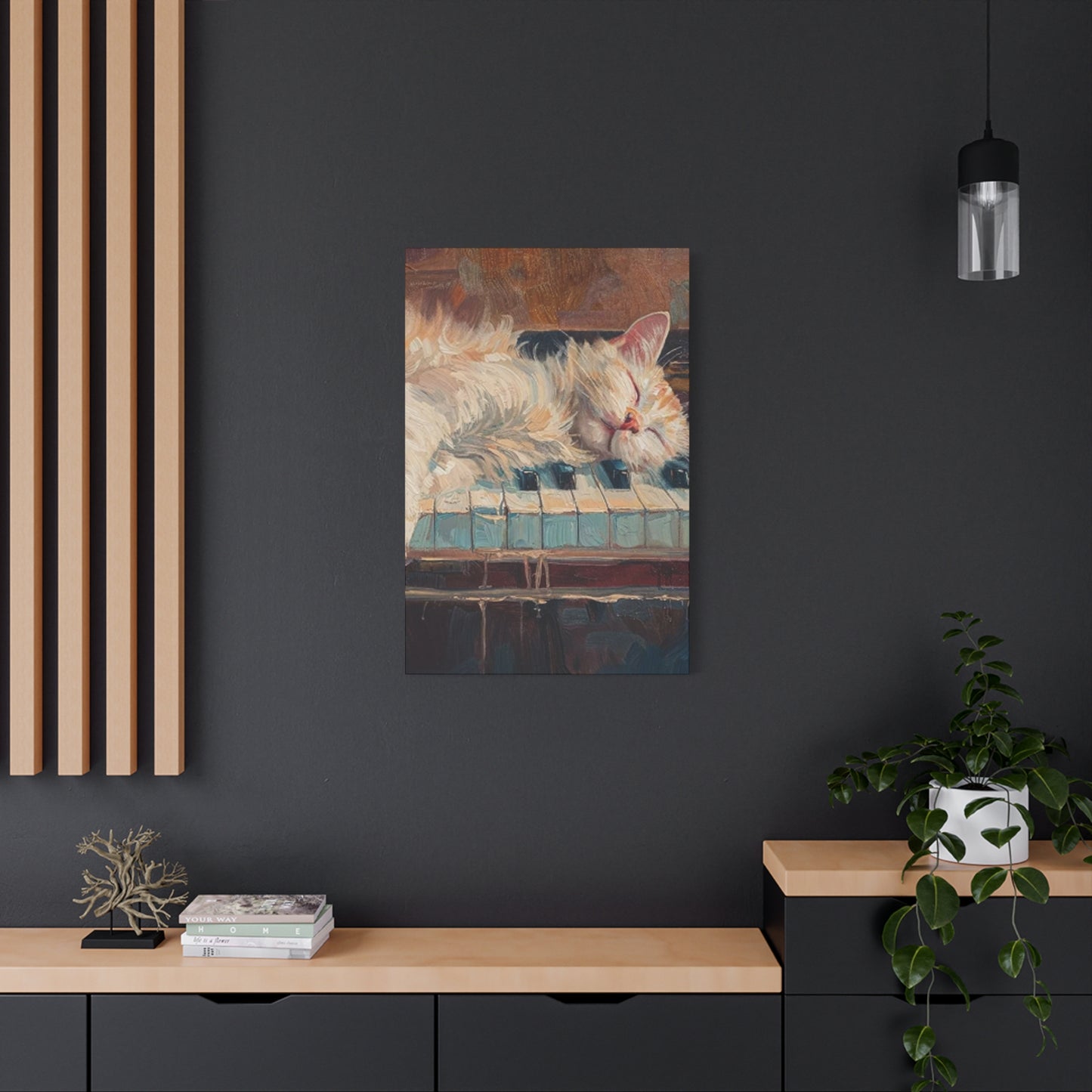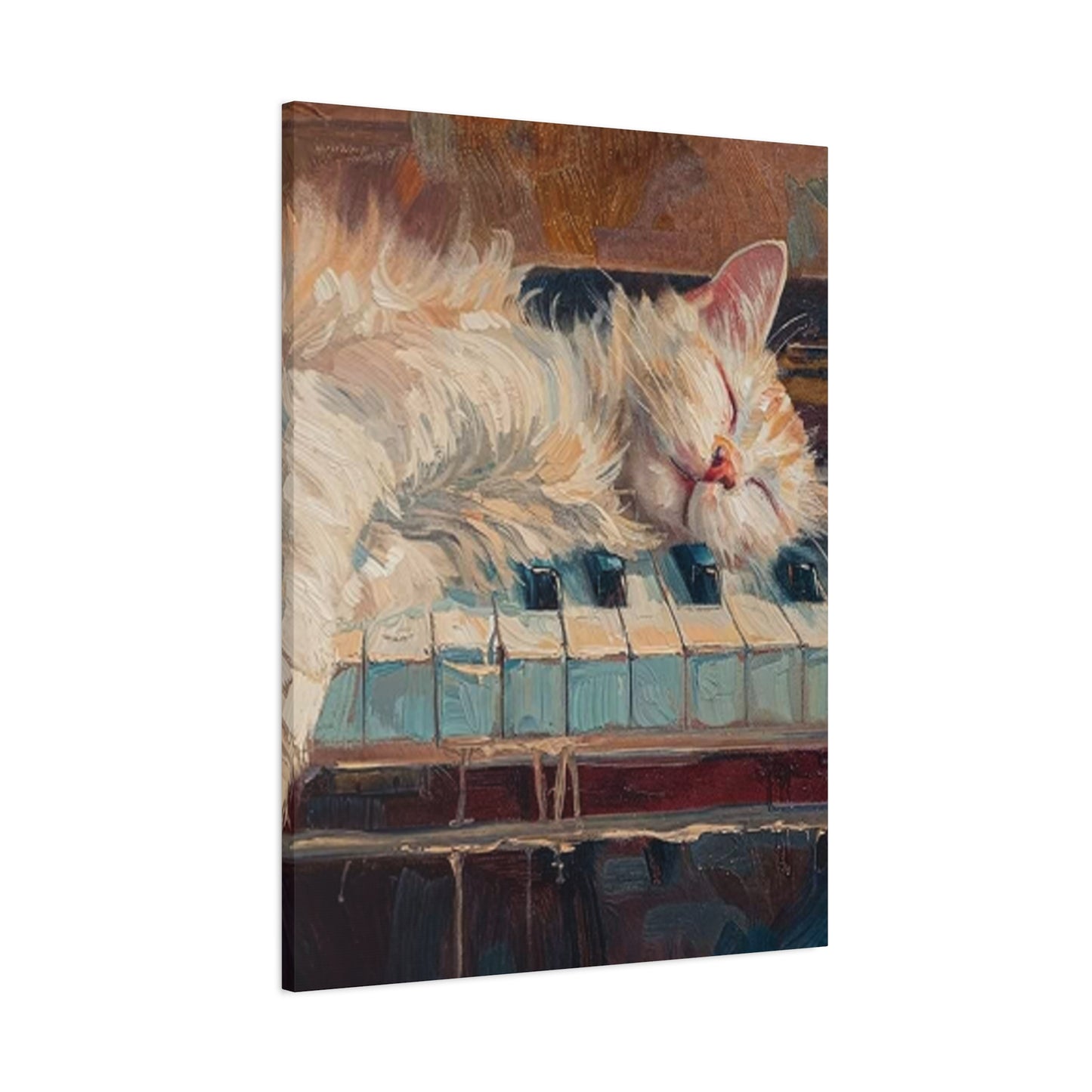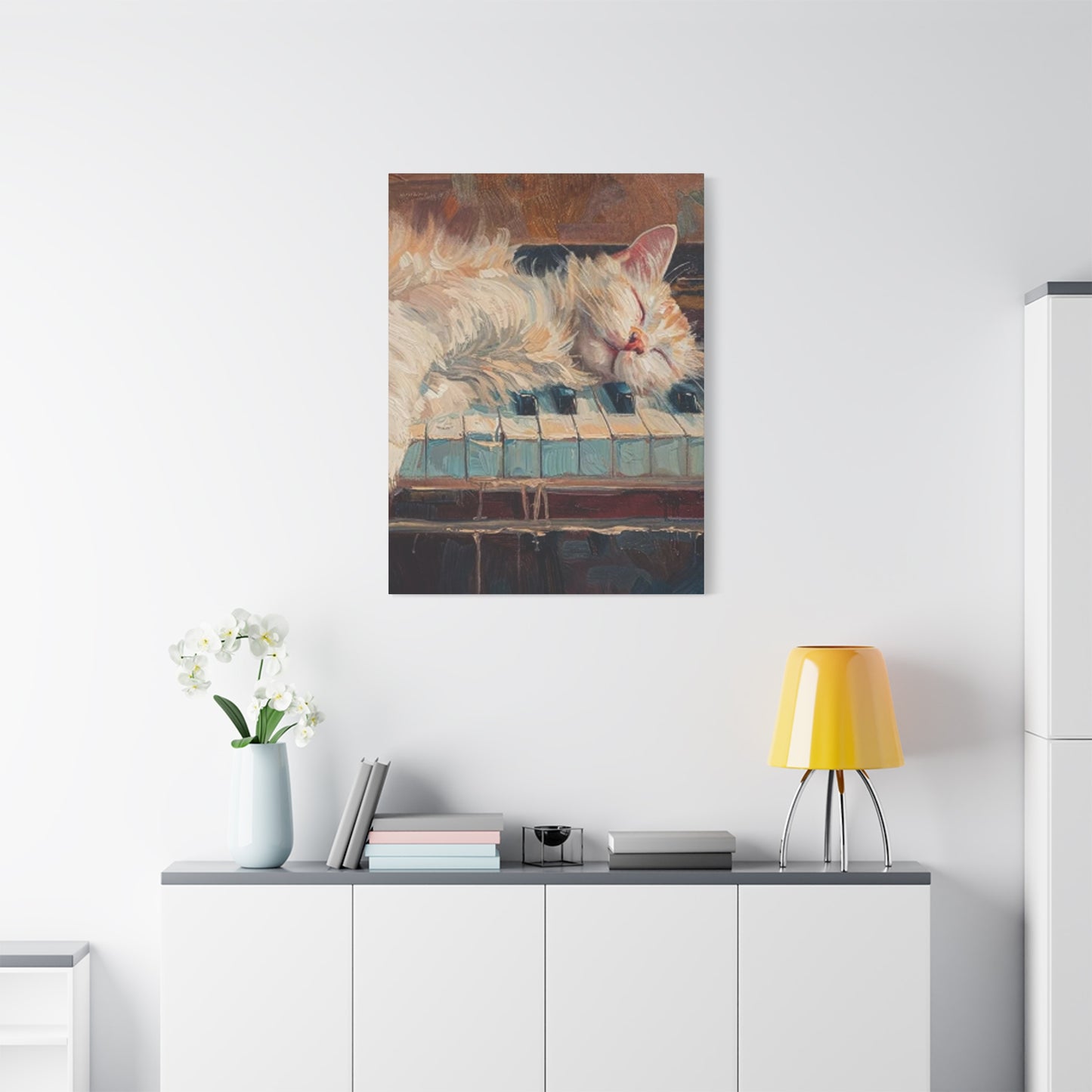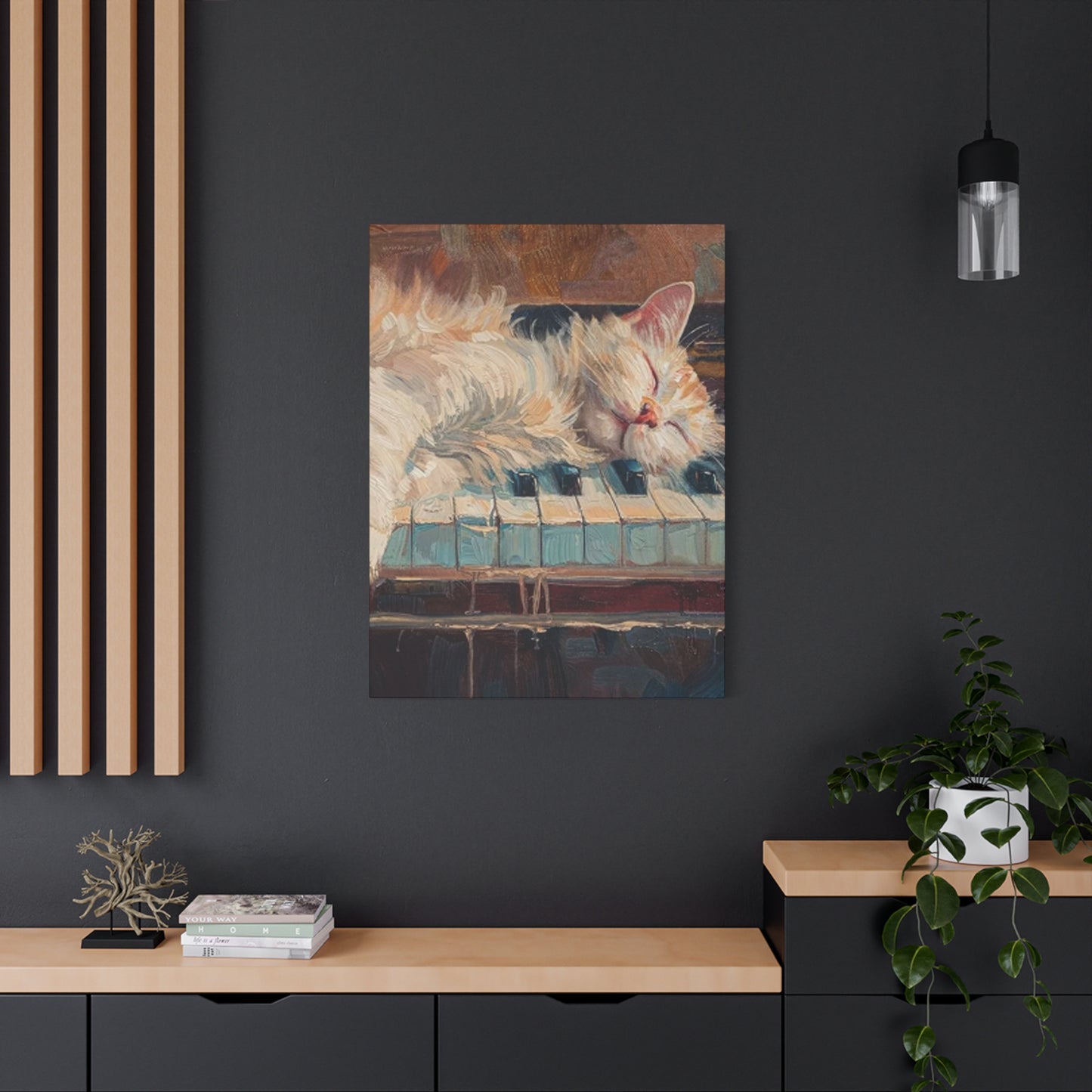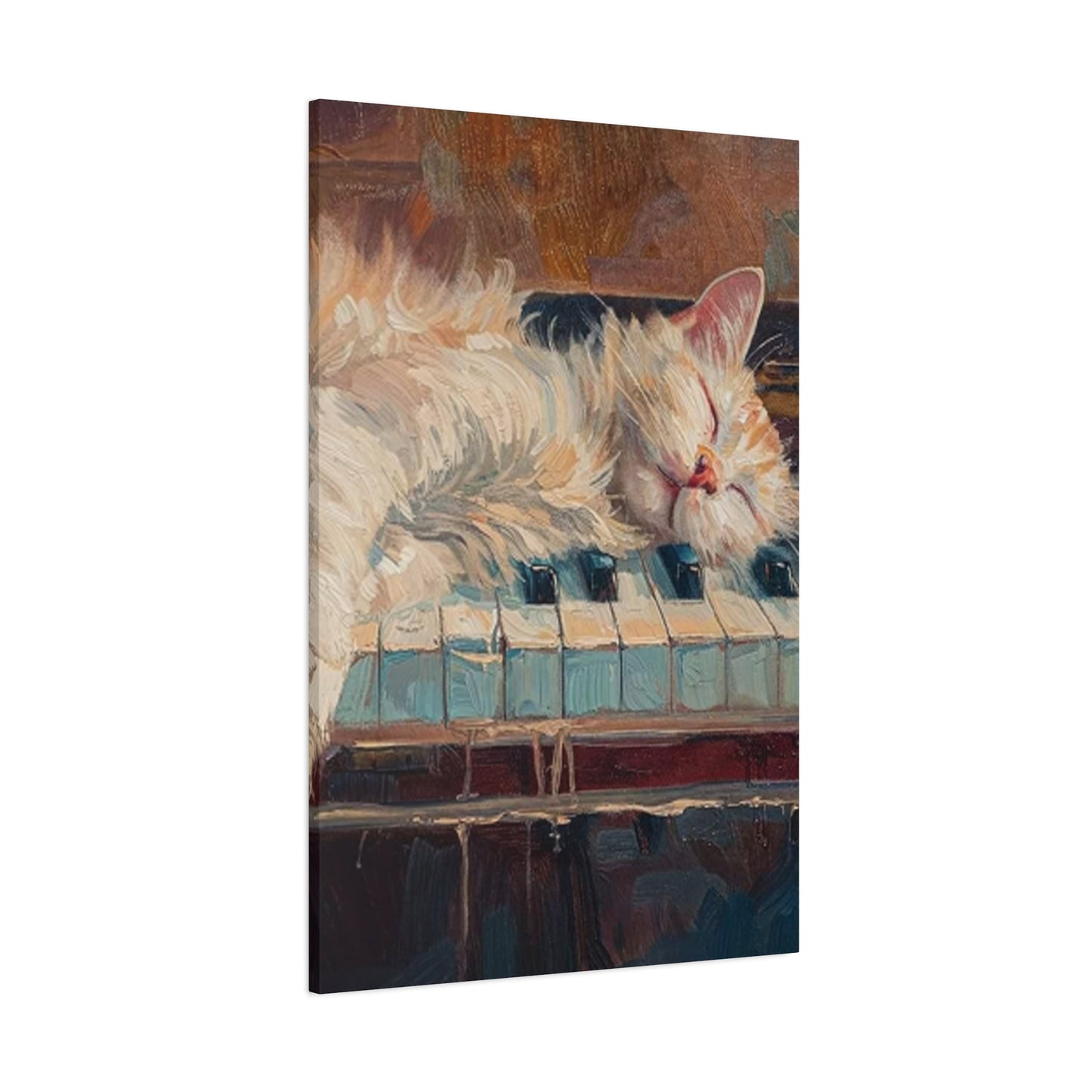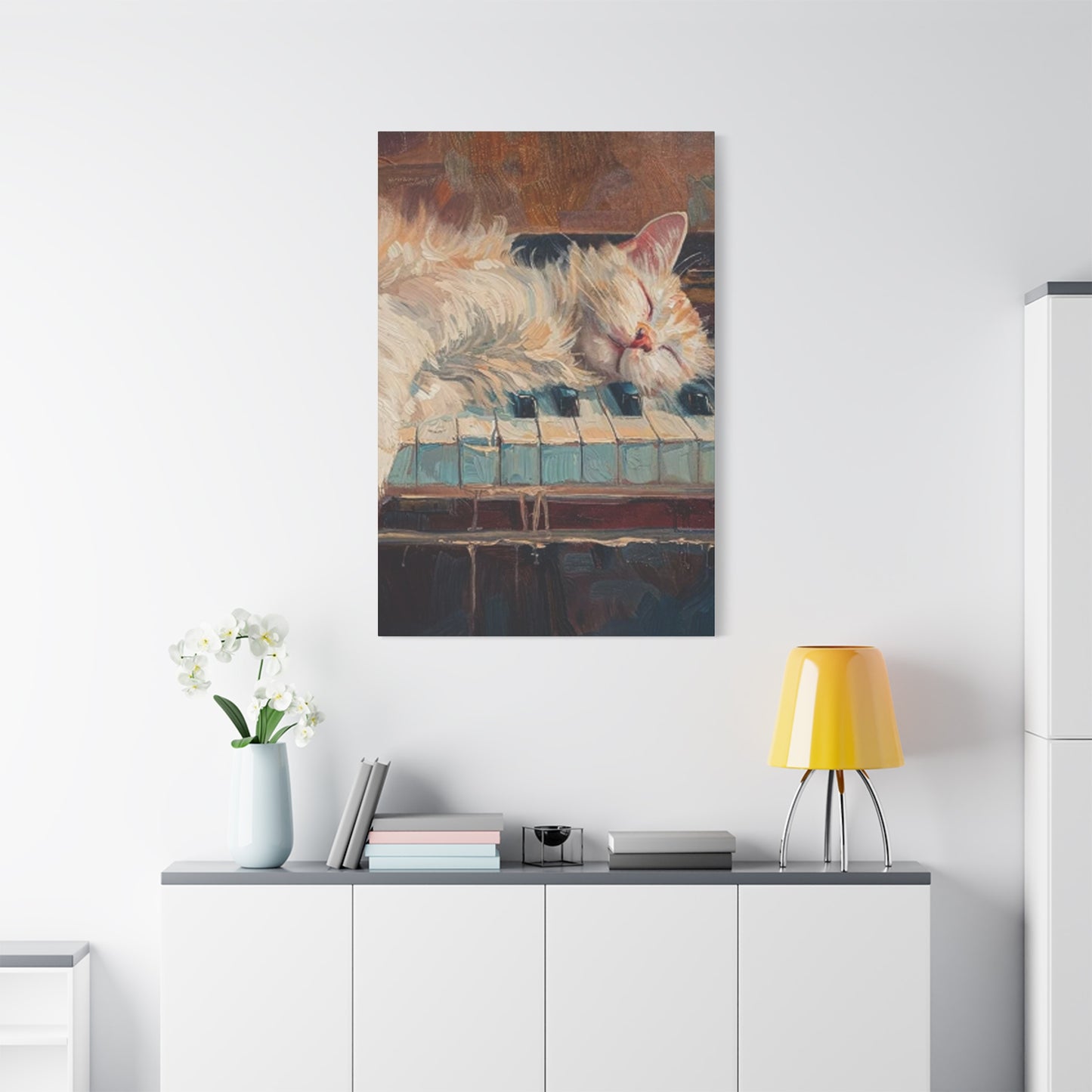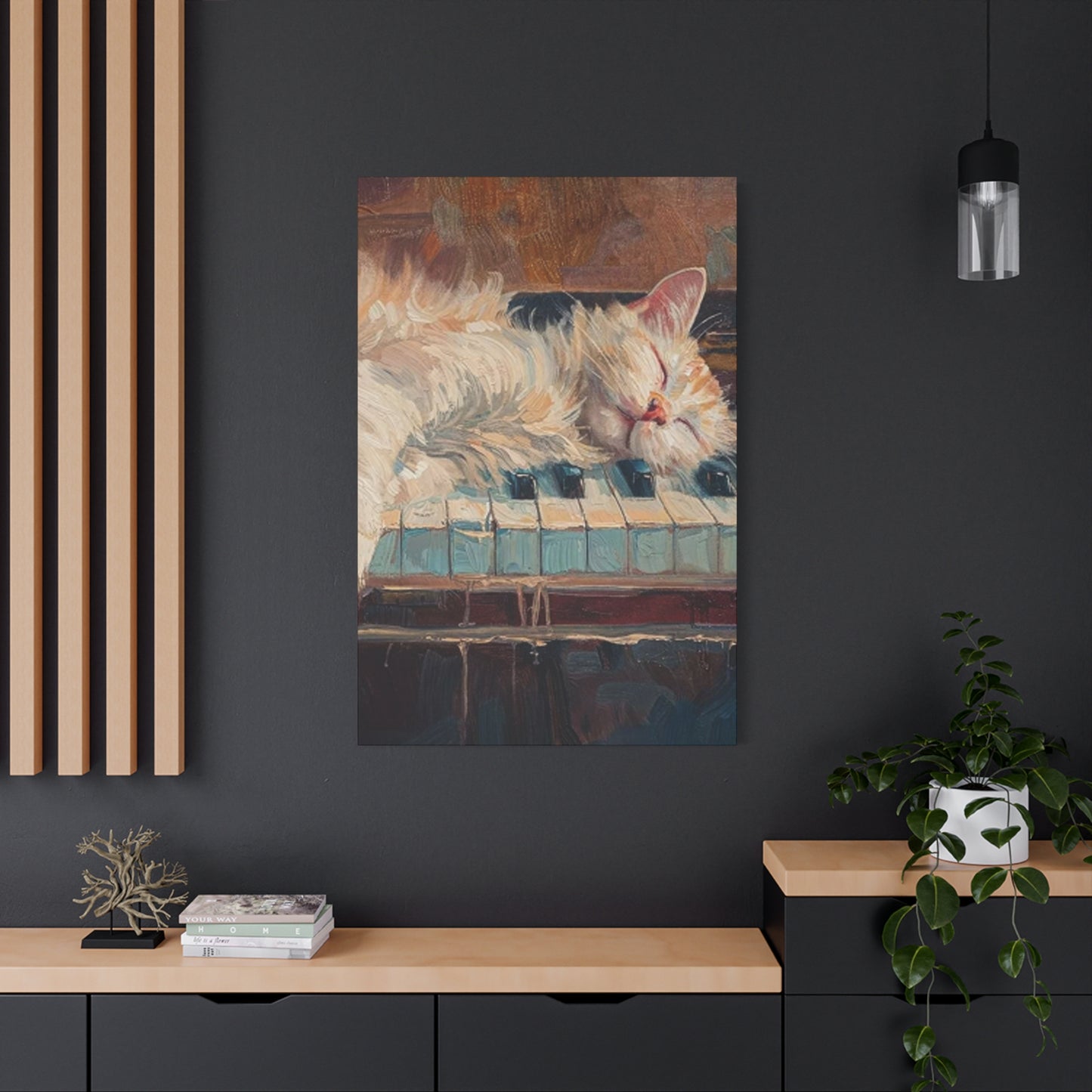Mixing Music and Nature: Cat Sleeping on Piano Wall Art for a Calming Space
The enchanting world of feline piano wall art has captured the hearts of art enthusiasts, cat lovers, and music aficionados alike. This delightful fusion of musical instruments and our beloved feline companions creates an atmosphere of warmth, creativity, and tranquility that resonates throughout any living space. The popularity of cat sleeping on piano artwork has grown exponentially in recent years, as homeowners seek unique ways to express their love for both music and cats while adding personality to their walls.
This artistic genre combines the elegance of musical instruments with the graceful presence of cats, creating visual narratives that speak to the soul. Whether you're a professional musician, a casual piano player, or simply someone who appreciates the beauty of feline companionship, these artistic pieces offer endless possibilities for home decoration. From contemporary digital prints to classic oil paintings, the variety of styles available ensures that every home can benefit from this charming aesthetic.
The appeal of cats resting on pianos extends beyond mere decoration. These images evoke feelings of comfort, creativity, and the peaceful coexistence between art forms. They remind us of lazy afternoons spent making music, with our feline friends as silent audience members or gentle companions. This symbolic relationship between cats and pianos has been celebrated throughout history, making it a timeless choice for wall art that never goes out of style.
The Enchantment of Feline Piano Artwork for Interior Design
The magnetic appeal of cats positioned gracefully on piano keys lies in their ability to transform any room into a haven of artistic expression. These captivating images possess an inherent charm that draws viewers into a world where music and feline grace intersect beautifully. The visual poetry created by a cat's silhouette against the backdrop of piano keys speaks to something deeply human about our desire for harmony, both musical and domestic.
When examining the artistic elements that make these pieces so compelling, we discover layers of meaning that extend far beyond surface aesthetics. The contrast between the geometric precision of piano keys and the flowing, organic lines of a resting cat creates visual tension that keeps the eye engaged. This juxtaposition represents the balance between structure and freedom, discipline and relaxation, human creativity and natural instinct.
The emotional resonance of these artworks stems from their ability to capture moments of perfect stillness. A cat sleeping peacefully on piano keys represents a pause in time, a moment when the world slows down and beauty takes precedence over productivity. This quality makes such artwork particularly valuable in our fast-paced modern world, where moments of tranquility are increasingly precious.
Color palettes in feline piano artwork often emphasize warm, inviting tones that create immediate emotional connections with viewers. Rich browns of wooden piano bodies, the cream and ebony of keys, and the varied hues of feline fur work together to establish cozy, intimate atmospheres. These natural color combinations make the artwork versatile enough to complement various interior design schemes while maintaining their distinctive character.
The lighting in these artistic compositions often plays a crucial role in establishing mood. Soft, diffused light filtering across piano surfaces and cat fur creates depth and dimension that draws viewers deeper into the scene. This careful attention to illumination transforms static images into dynamic visual experiences that change throughout the day as natural light shifts across the artwork.
Texture becomes another important element in the most successful examples of this art form. The smooth, polished surface of piano wood contrasts beautifully with the soft, fluffy appearance of cat fur. Artists who successfully capture these textural differences create pieces that viewers can almost feel, adding a tactile dimension to the visual experience.
Creating Warmth and Comfort Through Feline Musical Art
The power of cat and piano artwork to establish inviting, comfortable atmospheres in living spaces cannot be overstated. These images possess an almost magical ability to transform sterile rooms into warm, welcoming environments that immediately put visitors at ease. The psychological impact of viewing peaceful, contented cats in musical settings triggers positive emotional responses that enhance overall well-being.
Research in environmental psychology has consistently shown that artwork depicting peaceful scenes can significantly reduce stress levels and promote relaxation. When these calming images feature beloved animals like cats, the effect is amplified, creating spaces that feel more like sanctuaries than simple living areas. The addition of musical elements adds another layer of comfort, as pianos are often associated with childhood memories, family gatherings, and moments of creative expression.
The scale and placement of feline piano artwork within a room can dramatically influence its atmospheric impact. Large-scale pieces positioned as focal points create immediate emotional anchors, while smaller works clustered together can establish intimate conversation areas. The key lies in understanding how different sizes and arrangements affect the energy flow within a space.
Natural light interaction with these artworks throughout the day creates ever-changing moods that keep living spaces dynamic and interesting. Morning light might emphasize the peaceful sleeping quality of the cats, while evening illumination could highlight the warm wood tones of the piano, creating different emotional experiences at various times of day.
The versatility of cat and piano themes allows them to work effectively in numerous room types, from formal living areas to casual family rooms. In bedrooms, these peaceful images promote restful sleep, while in offices or study areas, they can provide calming focal points that reduce work-related stress. Music rooms and studios benefit particularly from this artwork, as it reinforces the creative, nurturing atmosphere essential for musical practice and composition.
Color temperature in these artworks plays a significant role in atmospheric creation. Warmer tones promote feelings of security and comfort, while cooler palettes can create more contemplative, meditative moods. The most effective pieces often incorporate both warm and cool elements, creating complex emotional landscapes that reward extended viewing.
Selecting Premium Feline Piano Prints for Wall Display
The process of choosing the perfect cat and piano wall art requires careful consideration of multiple factors, from artistic quality to practical installation requirements. High-quality prints should demonstrate excellent color reproduction, sharp detail resolution, and archival stability to ensure long-term enjoyment. The difference between amateur and professional-grade prints becomes immediately apparent when comparing color saturation, contrast levels, and overall image clarity.
Paper and canvas selection significantly impact both the visual appeal and longevity of feline piano artwork. Museum-quality papers offer exceptional detail reproduction and color accuracy, while canvas prints provide texture and depth that enhance the tactile qualities of the imagery. Each medium offers distinct advantages, and the choice often depends on the desired aesthetic effect and the specific room environment where the artwork will be displayed.
Print size considerations extend beyond simple wall measurements to include viewing distance, lighting conditions, and surrounding decor elements. Larger prints create dramatic focal points but require adequate wall space and proper viewing distances to be fully appreciated. Smaller works offer flexibility in placement and can be effectively grouped to create gallery walls or themed collections.
Professional printing techniques such as giclée ensure color consistency and archival quality that mass-produced prints cannot match. These high-end reproduction methods use pigment-based inks and specialized papers or canvases to create prints that rival original artworks in visual impact and longevity. The investment in quality printing pays dividends in terms of color permanence and overall aesthetic satisfaction.
Limited edition prints add exclusivity and potential investment value to feline piano artwork collections. These numbered editions often feature enhanced printing techniques, special papers, or unique finishing treatments that distinguish them from unlimited reproductions. For serious collectors, limited editions represent the perfect balance between accessibility and exclusivity.
Authentication and provenance become important considerations when selecting higher-value pieces. Certificates of authenticity, artist signatures, and detailed provenance records add value and ensure the legitimacy of purchases. Even reproduction prints benefit from clear documentation of the original artwork, printing methods, and edition information.
Creative DIY Projects for Homemade Feline Piano Art
The satisfaction of creating personalized cat and piano wall art through DIY projects offers unique rewards that purchased pieces cannot match. These hands-on projects allow for complete customization while providing creative outlets that can be both therapeutic and rewarding. From simple photograph modifications to complex mixed-media compositions, DIY approaches offer endless possibilities for personal expression.
Digital art creation has democratized the artistic process, allowing anyone with basic computer skills to produce professional-looking feline piano artwork. Software applications ranging from simple photo editors to sophisticated design programs provide tools for manipulating existing images, creating original compositions, or combining elements from multiple sources. The key lies in understanding fundamental design principles while experimenting with creative techniques.
Collage and mixed-media approaches offer tactile, hands-on alternatives to digital creation. These projects can incorporate actual sheet music, piano key cutouts, fabric elements, and other materials that add dimension and texture to finished pieces. The layering of different materials creates visual depth and interest that purely digital works sometimes lack.
Photography enthusiasts can create original feline piano artwork by staging their own compositions with willing feline models and available pianos. These personal projects often result in the most meaningful wall art because they capture actual pets in genuine moments. The challenge lies in patience, as cats rarely cooperate with artistic visions on human schedules.
Painting and drawing projects allow for complete artistic freedom while developing traditional artistic skills. Whether working in watercolors, acrylics, oils, or drawing media, creating original feline piano artwork provides deep satisfaction and results in truly unique pieces. These handmade works carry emotional significance that reproductions cannot match.
Upcycling and repurposing projects transform existing materials into new artistic expressions. Old sheet music can become backgrounds for cat silhouettes, while discarded piano keys might be incorporated into three-dimensional wall sculptures. These environmentally conscious projects often produce the most interesting and conversation-worthy results.
Frame and mounting innovations can transform simple prints or drawings into sophisticated wall installations. Creative framing techniques, layered matting, shadow boxes, and unconventional mounting methods add professional finishing touches to DIY projects. The presentation often matters as much as the artwork itself in creating impactful wall displays.
Incorporating Musical Feline Art in Music Studios and Practice Rooms
Music rooms and practice spaces benefit tremendously from the inclusion of cat and piano wall art, as these images reinforce the creative, nurturing atmosphere essential for musical development. The presence of peaceful, content cats in musical settings creates psychological connections between comfort and creativity that can enhance practice sessions and reduce performance anxiety.
The acoustic considerations of music rooms require careful artwork selection to avoid interfering with sound quality. Hard surfaces like glass-covered prints can create unwanted reflections, while fabric-based works might absorb too much sound. The ideal choices often involve canvas prints or other materials that neither reflect nor absorb sound excessively.
Inspiration and motivation during practice sessions can be significantly enhanced by surrounding musicians with imagery that celebrates the joy and beauty of music-making. Cat and piano artwork serves as gentle reminders that music should bring pleasure and satisfaction, not just technical achievement. This psychological support becomes particularly valuable during challenging practice periods.
Studio lighting designed to illuminate both instruments and artwork creates multi-functional spaces that serve both practical and aesthetic needs. Adjustable lighting systems allow for proper music reading conditions while also showcasing wall art effectively. The interplay between functional and decorative lighting adds professional polish to music spaces.
Sound isolation requirements in serious music studios must be considered when selecting and installing artwork. Heavy frames and mounting systems can interfere with acoustic treatments, while lightweight pieces might vibrate with loud music. Professional installation that considers both aesthetic and acoustic requirements ensures optimal performance of both music and art.
Student motivation in music education settings can be enhanced through inspirational artwork that makes practice spaces more welcoming and encouraging. Young musicians often respond positively to friendly, accessible imagery that makes music feel approachable rather than intimidating. Cat and piano artwork strikes this balance perfectly.
Symbolic Meaning and Cultural Significance of Cats with Pianos
The symbolic relationship between cats and pianos in artistic expression draws from deep cultural associations that have developed over centuries. Cats represent independence, creativity, intuition, and mystery, while pianos symbolize culture, refinement, emotional expression, and human creativity. Together, they create rich symbolic narratives that resonate across different cultures and artistic traditions.
Historical context reveals that cats have long been associated with artists, writers, and musicians, serving as companions and muses throughout creative history. Many famous composers and musicians have shared their lives and studios with cats, creating real-world foundations for the artistic pairing we see in contemporary wall art. These historical connections add depth and authenticity to modern interpretations.
The feminine principle in many cultures associates cats with intuition, emotion, and the mysterious aspects of creativity, while pianos represent the more structured, technical aspects of musical expression. The combination suggests harmony between intuitive and learned approaches to creativity, making these images particularly appealing to artists and creative individuals.
Psychological interpretations of cat and piano imagery often focus on themes of balance, patience, and the integration of different aspects of personality. The patient cat waiting quietly while music is made represents the contemplative, receptive aspects of creativity that complement the active, expressive elements of musical performance.
Cultural variations in the interpretation of cats and music reveal interesting differences in symbolic meaning across different societies. While Western cultures often emphasize the romantic, sentimental aspects of these combinations, Eastern traditions might focus more on the meditative, spiritual qualities suggested by the imagery.
Modern therapeutic applications of cat and piano imagery in art therapy and music therapy settings demonstrate the continuing relevance of these symbolic associations. The calming, nurturing qualities of cats combined with the expressive, emotional qualities of music create powerful tools for healing and personal growth.
Blending Musical and Feline Elements in Contemporary Wall Design
The integration of musical and feline themes in modern wall decor requires careful attention to balance, scale, and stylistic consistency to achieve cohesive, sophisticated results. Contemporary design approaches often favor clean lines, minimal color palettes, and strategic placement that allows each element to contribute to the overall aesthetic without overwhelming the space.
Scale relationships between different wall elements become crucial when combining musical instruments, cats, and other decorative elements. Large piano images require careful balance with smaller feline elements, while collections of smaller pieces need unifying elements to create cohesive displays. Understanding these proportional relationships prevents cluttered, chaotic appearances.
Color coordination between musical and feline elements ensures visual harmony throughout the space. The natural color palettes of both pianos and cats often work well together, with warm wood tones complementing various fur colors and patterns. Strategic use of accent colors can tie different pieces together while maintaining overall cohesion.
Style consistency becomes particularly important when mixing different artistic approaches within the same space. Photographic cat images might clash with illustrated piano elements unless carefully selected for compatible styles. The key lies in identifying unifying aesthetic elements that allow different artistic approaches to coexist harmoniously.
Lighting design for combined musical and feline wall displays requires attention to both practical and aesthetic considerations. Proper illumination enhances the visual impact of artwork while avoiding glare or shadows that might interfere with music reading or instrument playing. Adjustable lighting systems offer flexibility for different activities and times of day.
Installation considerations for mixed-media wall displays often involve complex mounting systems that accommodate different piece sizes, weights, and materials. Professional installation ensures that all elements are securely mounted while maintaining the intended visual relationships between pieces.
Professional Framing Techniques for Feline Piano Artwork
The art of framing cat and piano prints requires understanding how different framing choices affect both the aesthetic impact and longevity of the artwork. Professional framing goes far beyond simply adding borders around images; it involves careful consideration of materials, proportions, colors, and preservation techniques that enhance and protect the artwork for years to come.
Matting selection plays a crucial role in the visual presentation of feline piano artwork. The width, color, and texture of matting can dramatically alter the perceived impact of a piece. Wider mats create more formal, gallery-like presentations, while narrower mats maintain intimacy and casual appeal. Color choices should complement both the artwork and the surrounding decor without overwhelming the central image.
Frame material and style selections must balance aesthetic preferences with practical considerations such as weight, durability, and cost. Wood frames offer warmth and traditional appeal that often complements the organic nature of cat and piano imagery, while metal frames provide contemporary sophistication. The choice depends on the specific artwork, room decor, and personal preferences.
Glass and glazing options significantly impact both the appearance and preservation of framed artwork. Standard glass provides basic protection but can create glare problems in brightly lit rooms. Museum glass eliminates reflections and provides superior UV protection, making it ideal for valuable pieces or rooms with significant sun exposure. Anti-reflective coatings enhance viewing while protecting the artwork.
Conservation framing techniques become important for valuable or sentimental pieces that require long-term preservation. Acid-free matting materials, archival mounting techniques, and proper spacing between glass and artwork prevent deterioration and ensure that pieces retain their original beauty for decades. These techniques represent worthwhile investments for important artworks.
Corner and joining techniques affect both the structural integrity and visual appeal of frames. Traditional methods like mortise and tenon joints provide superior strength and longevity, while modern techniques might prioritize cost-effectiveness or specific aesthetic effects. Understanding these differences helps in making informed decisions about framing quality and longevity.
Therapeutic Benefits and Relaxation Through Feline Musical Art
The calming influence of cat and piano artwork extends beyond simple aesthetic pleasure to provide genuine therapeutic benefits for stress reduction and emotional well-being. Research in art therapy and environmental psychology has demonstrated that peaceful imagery can significantly impact mental health, making these artworks valuable additions to any wellness-focused living environment.
Stress reduction mechanisms activated by viewing tranquil cat and piano scenes involve complex neurological processes that promote relaxation and emotional balance. The brain's response to peaceful imagery includes decreased cortisol production, lowered heart rate, and activation of parasympathetic nervous system responses that counteract the effects of chronic stress.
Sleep quality improvement often results from bedroom placement of calming cat and piano artwork. The peaceful, restful imagery helps establish mental associations between the sleeping environment and tranquility, making it easier to transition from daily stress to restful sleep. This psychological conditioning can be particularly beneficial for individuals who struggle with sleep anxiety or racing thoughts.
Meditation and mindfulness practices can be enhanced by focusing on the contemplative qualities of cat and piano imagery. The patient, present-moment awareness suggested by cats at rest provides excellent focal points for meditation, while the creative, expressive qualities of musical instruments inspire mindful engagement with personal creativity.
Anxiety management benefits from the stability and comfort suggested by familiar, comforting imagery. Cats represent safety and contentment for many people, while pianos suggest structure and creative control. Together, these elements create visual anchors that can help manage anxiety during difficult periods.
Workplace stress reduction through appropriate artwork placement can significantly improve job satisfaction and productivity. The calming influence of cat and piano imagery in office environments provides mental breaks from work pressure while maintaining professional appropriateness. These visual respites become particularly valuable in high-stress work environments.
Perfect Harmony Between Cats and Musical Expression in Art
The natural affinity between cats and music has fascinated artists, musicians, and cat lovers throughout history, creating a rich tradition of artistic expression that celebrates this unique relationship. The qualities that make cats excellent companions for musicians, including their quiet presence, intuitive understanding of mood, and appreciation for routine, translate beautifully into visual art that captures these special bonds.
Historical documentation of famous musician-cat partnerships reveals the depth of these relationships and their influence on creative work. From classical composers to contemporary artists, cats have served as both inspiration and companionship throughout the creative process. These real-world relationships provide authentic foundations for the artistic interpretations we see in wall art today.
Musical sensitivity in cats has been observed and documented by musicians throughout history. Many cats demonstrate preferences for certain types of music, respond to rhythm and melody, and seem to understand the emotional content of musical performances. This natural musical appreciation makes cats ideal subjects for artwork that celebrates musical themes.
The creative process benefits from feline companionship in numerous ways that artists have captured in their work. Cats provide non-judgmental presence during practice sessions, inspiration through their natural grace and beauty, and emotional support during challenging creative periods. These supportive qualities are often reflected in artwork that shows cats as gentle, nurturing presences in musical settings.
Rhythm and movement connections between cats and music appear in artwork that captures the natural rhythm of feline movement and the way cats respond to musical rhythms. The graceful, flowing lines of cat movement often mirror the melodic lines in music, creating visual harmonies that resonate with both cat lovers and music enthusiasts.
Emotional resonance between human musical expression and feline companionship creates deep, meaningful relationships that inspire lasting artistic tributes. The mutual benefit and genuine affection in these relationships provide authentic emotional content that elevates cat and piano artwork beyond simple decoration to meaningful artistic expression.
Minimalist Approaches to Feline Piano Art in Contemporary Spaces
The minimalist aesthetic movement has embraced cat and piano imagery with particular enthusiasm, finding in these subjects the perfect balance between meaningful content and visual simplicity that defines successful minimalist design. The clean lines of piano keys and the elegant curves of feline forms provide ideal elements for minimalist artistic expression.
Color palette restrictions in minimalist design challenge artists to create impact through composition, form, and subtle tonal variations rather than bold color contrasts. Cat and piano subjects work exceptionally well within these constraints, as their natural color relationships often fall within the neutral palettes favored by minimalist designers.
Negative space utilization becomes crucial in minimalist cat and piano artwork, with empty areas serving as active design elements rather than simply backgrounds. The strategic use of negative space can emphasize the peaceful, contemplative qualities of the subject matter while creating sophisticated visual balance.
Geometric composition in minimalist feline piano art often emphasizes the architectural qualities of pianos alongside the organic curves of cat forms. This interplay between geometric and organic elements creates visual tension that keeps minimalist pieces interesting without violating the principles of simplicity and restraint.
Texture and material considerations in minimalist presentations focus on subtle variations that add interest without overwhelming the essential simplicity of the design. The contrast between smooth piano surfaces and soft cat fur provides natural textural variety that enhances minimalist compositions.
Installation approaches for minimalist cat and piano artwork emphasize clean presentation methods that don't distract from the artwork itself. Simple, unadorned frames, strategic lighting, and careful placement create gallery-like presentations that allow the essential beauty of the subjects to speak for themselves.
Large Format Displays for Maximum Visual Impact
The dramatic potential of oversized cat and piano artwork transforms ordinary walls into commanding focal points that define entire rooms. Large format presentations require careful consideration of viewing distances, lighting conditions, and spatial relationships to achieve maximum impact without overwhelming the surrounding environment.
Scale considerations for large cat and piano prints involve complex calculations of viewing distance, wall size, and room proportions. Pieces that appear perfectly sized in galleries or online previews may prove too large or too small for specific residential applications. Professional consultation can prevent costly mistakes in scale selection.
Printing technology for large format cat and piano artwork has advanced significantly, allowing for museum-quality reproduction at sizes that were previously impossible or prohibitively expensive. Modern large format printers can maintain exceptional detail and color accuracy even at billboard-size dimensions, opening new possibilities for residential art display.
Installation challenges for oversized artwork require professional expertise to ensure secure mounting while protecting both the artwork and the wall structure. The weight and size of large format pieces often exceed the capabilities of standard hanging hardware, necessitating specialized mounting systems and potentially structural reinforcement.
Viewing experience optimization for large cat and piano displays involves careful attention to room layout, furniture placement, and lighting design. The goal is to create optimal viewing positions that allow the full impact of the artwork to be appreciated while maintaining functional room arrangements.
Room proportion relationships become critical when incorporating large cat and piano artwork into existing spaces. The scale of the artwork must complement rather than dominate the architectural features of the room, creating harmony between built and decorative elements.
Thoughtful Gift Selection for Feline Enthusiasts
The universal appeal of cats makes cat and piano artwork excellent gift choices for a wide range of recipients, from serious music lovers to casual cat enthusiasts. The key to successful gift selection lies in understanding the recipient's aesthetic preferences, living situation, and personal style to choose pieces that will be genuinely appreciated and appropriately displayed.
Recipient assessment involves considerate observation of existing decor, expressed preferences, and lifestyle factors that might influence artwork selection. A formal living room might benefit from elegant, sophisticated pieces, while a casual family room could accommodate more playful, whimsical interpretations of the cat and piano theme.
Customization options add personal meaning to cat and piano artwork gifts, making them especially memorable and significant. Custom pieces featuring the recipient's own pets or specific piano models create unique, irreplaceable gifts that demonstrate thoughtfulness and attention to personal details.
Presentation enhancement through professional framing, elegant gift wrapping, or special packaging elevates the gift-giving experience and demonstrates the giver's appreciation for the recipient. Investment in quality presentation often matters as much as the artwork itself in creating positive gift experiences.
Occasion appropriateness varies with different types of cat and piano artwork, from celebratory pieces suitable for graduations or achievements to comforting images appropriate for sympathy or support situations. Understanding the emotional tone of the occasion helps guide appropriate artistic selection.
Size and placement considerations for gift artwork require thoughtful estimation of the recipient's available wall space and existing decor. Smaller pieces offer placement flexibility, while larger works require more specific spatial requirements that might not be available in all living situations.
Color Theory and Warm Tonal Applications
The psychological impact of warm color palettes in cat and piano artwork creates inviting, comfortable atmospheres that enhance the natural appeal of these subjects. Understanding color theory principles helps both artists and collectors make informed decisions about pieces that will create desired emotional responses in specific environments.
Temperature relationships between colors significantly affect the mood and energy of cat and piano artwork. Warm tones including reds, oranges, and yellows create feelings of coziness and intimacy, while cooler blues and greens provide calming, meditative qualities. The most successful pieces often incorporate both temperature ranges for visual and emotional complexity.
Natural color harmonies found in cat fur and piano wood provide excellent starting points for color palette development. The rich browns of walnut piano cases complement the warm tones found in orange tabby cats, while the cool grays of piano keys harmonize beautifully with gray cat fur patterns.
Lighting interaction with warm-toned cat and piano artwork changes throughout the day, creating dynamic visual experiences that keep the artwork interesting and engaging. Morning light might emphasize the golden tones in cat fur, while evening illumination could bring out the rich warmth of wooden piano surfaces.
Emotional responses to warm color palettes in cat and piano artwork tend toward feelings of security, comfort, and contentment. These positive emotional associations make warm-toned pieces particularly suitable for bedrooms, family rooms, and other spaces where relaxation and comfort are priorities.
Room compatibility with warm-toned artwork depends on existing color schemes, lighting conditions, and intended room functions. Warm artwork generally works best in rooms with natural wood elements, earth-tone color schemes, or traditional decorating styles that emphasize comfort over formality.
Historical Masters and Feline Musical Art Traditions
The tradition of depicting cats in artistic settings extends back centuries, with many renowned artists including felines in their musical and domestic scenes. These historical precedents provide context and legitimacy for contemporary cat and piano artwork while demonstrating the enduring appeal of this artistic theme.
Renaissance period artists occasionally included cats in domestic scenes featuring musical instruments, though these appearances were often symbolic rather than purely decorative. The cat might represent domestic harmony, feminine attributes, or the civilized nature of household life in contrast to the wild world outside.
Baroque and Rococo artistic traditions embraced domestic scenes with increasing frequency, and cats appeared more regularly as companions in musical settings. The elaborate interior scenes popular during these periods often featured harpsichords or other keyboard instruments alongside various domestic animals including cats.
Nineteenth-century genre painting elevated domestic scenes to new artistic heights, with many masters creating detailed works featuring musical instruments and household pets. The growing middle class appreciation for domestic comfort and musical accomplishment made such scenes particularly popular during this period.
Impressionist and Post-Impressionist movements often featured cats in domestic settings, with several notable artists creating memorable works that combined feline subjects with musical themes. The loose, expressive brushwork of these movements proved particularly well-suited to capturing the soft, flowing forms of cat fur and the atmospheric qualities of musical interiors.
Contemporary artistic traditions have embraced cat and piano themes with enthusiasm, creating new interpretations that range from photorealistic representations to abstract interpretations. Modern artists draw on both historical precedents and contemporary sensibilities to create works that speak to current aesthetic preferences while honoring artistic traditions.
Designing Comfortable Reading Spaces with Musical Feline Art
The creation of dedicated reading nooks and quiet spaces benefits tremendously from the inclusion of cat and piano artwork that reinforces the peaceful, contemplative atmosphere ideal for reading and reflection. These images provide visual anchors that help define intimate spaces within larger rooms while creating psychological associations between the space and calm, focused activities.
Lighting requirements for reading spaces must balance functional needs with aesthetic considerations when displaying cat and piano artwork. Adequate illumination for reading should complement rather than compete with artwork lighting, creating harmonious environments that serve both practical and decorative purposes effectively.
Furniture arrangement in reading areas enhanced by cat and piano artwork should create natural sight lines between seating and wall displays while maintaining intimate, enclosed feelings that promote concentration and relaxation. The placement of comfortable seating in relation to artwork viewing angles affects both the reading experience and artistic appreciation.
Sound considerations in reading spaces might be influenced by the musical themes in cat and piano artwork, with some readers finding that soft background music enhances their reading experience. The artistic reminder of musical possibilities can inspire the creation of multi-sensory reading environments that engage several senses simultaneously.
Personal comfort elements including soft textiles, warm lighting, and favorite books combine with cat and piano artwork to create reading spaces that feel like personal sanctuaries. The calming influence of cat imagery and the creative inspiration of musical themes support both relaxation and intellectual engagement.
Seasonal adaptations of reading spaces can be enhanced through changeable elements that complement the consistent presence of cat and piano artwork. Seasonal plants, throw pillows, or lighting adjustments can refresh the space while maintaining the stable, comforting presence of the permanent wall art.
Preservation of Canvas Art Prints
The longevity and appearance of cat and piano canvas prints depend heavily on proper care, appropriate environmental conditions, and regular maintenance routines that prevent damage while preserving original beauty. Understanding these requirements ensures that investment in quality artwork provides years of enjoyment and maintains its value over time.
Cleaning techniques for canvas prints require gentle approaches that remove dust and surface contamination without damaging the printed surface or canvas material. Soft brushes, microfiber cloths, and specialized cleaning products designed for canvas care should be used according to manufacturer recommendations to prevent irreversible damage.
Environmental control factors including humidity, temperature, and air quality significantly impact the preservation of cat and piano canvas artwork. Stable conditions within recommended ranges prevent expansion, contraction, and chemical changes that can cause cracking, fading, or other forms of deterioration over time.
UV protection through appropriate glass coverings, window treatments, or strategic placement away from direct sunlight prevents the photochemical damage that causes colors to fade and materials to become brittle. Even indirect sunlight can cause cumulative damage over extended periods, making protection essential for long-term preservation.
Storage considerations for canvas artwork during moving, renovation, or seasonal rotation require proper materials and techniques to prevent creasing, tearing, or surface damage. Professional storage methods using acid-free materials and appropriate support systems ensure that artwork remains in excellent condition during storage periods.
Professional restoration options become important when canvas prints experience damage from accidents, environmental factors, or aging. Understanding when DIY repair attempts might cause additional damage versus when professional intervention is necessary helps preserve both artwork value and appearance.
Vintage Aesthetic Integration with Contemporary Feline Piano Art
The combination of vintage decorating styles with contemporary cat and piano artwork creates sophisticated, layered interiors that celebrate both historical design traditions and current artistic expression. This approach requires careful attention to color coordination, style compatibility, and historical authenticity to achieve cohesive results.
Antique furniture compatibility with modern cat and piano artwork depends on understanding the design principles that unite different historical periods. Shared elements like warm wood tones, classical proportions, or traditional craftsmanship can bridge temporal gaps between vintage furniture and contemporary artistic expressions.
Color palette coordination between vintage decor elements and contemporary artwork often centers on the rich, warm tones naturally present in both aged materials and cat and piano imagery. The patina of aged wood, brass, and fabric complements the earth tones commonly found in feline and musical artwork.
Texture relationships between vintage materials and contemporary prints create visual interest and depth that enhances both elements. The smooth surface of modern canvas prints contrasts beautifully with the worn, textured surfaces of antique furniture and accessories, creating sophisticated interplays between old and new.
Historical accuracy considerations become important when attempting to create authentically vintage atmospheres enhanced by contemporary artwork. Research into period-appropriate color schemes, furniture arrangements, and decorative elements helps ensure that modern additions feel intentional rather than accidental.
Lighting approaches for vintage-contemporary combinations often emphasize warm, atmospheric illumination that flatters both antique materials and modern artwork. Traditional lighting fixtures with updated technology can provide appropriate illumination while maintaining historical character.
Monochromatic Photography Art for Sophisticated Displays
Black and white cat and piano photography offers timeless elegance and sophisticated aesthetic appeal that transcends decorating trends and color scheme limitations. The absence of color forces viewers to focus on composition, texture, contrast, and emotional content, often resulting in more powerful and enduring artistic experiences.
Contrast manipulation in monochromatic cat and piano photography can dramatically affect the mood and visual impact of the final image. High contrast treatments create bold, graphic effects that work well in contemporary settings, while softer contrast approaches emphasize the gentle, peaceful qualities of the subject matter.
Texture emphasis becomes particularly important in black and white photography, as the absence of color places greater importance on surface qualities and material differences. The contrast between smooth piano surfaces and soft cat fur becomes more pronounced and visually significant in monochromatic presentations.
Lighting techniques for black and white cat and piano photography require careful attention to shadow placement, highlight preservation, and overall tonal balance. The interplay of light and shadow becomes the primary tool for creating depth, dimension, and visual interest in the absence of color information.
Print quality considerations for monochromatic artwork include paper selection, tonal range preservation, and archival stability factors that ensure long-term beauty and value. High-quality black and white prints require specialized printing techniques and materials to achieve optimal results.
Framing and presentation options for black and white cat and piano photography often emphasize clean, elegant approaches that complement the sophisticated simplicity of monochromatic imagery. Traditional black frames, white matting, and museum-quality glass create classic presentations that never go out of style.
Modern Digital Art Techniques for Feline Musical Themes
Contemporary digital art creation has revolutionized the production of cat and piano artwork, offering artists unprecedented control over color, composition, lighting, and texture while enabling techniques that would be impossible with traditional media. These technological advances have democratized art creation while expanding creative possibilities for both professional and amateur artists.
Software selection for digital cat and piano art creation ranges from simple photo editing applications to sophisticated professional design suites that offer advanced capabilities for original composition and manipulation. Understanding the strengths and limitations of different software options helps artists choose tools that match their skill levels and creative objectives.
Layering techniques in digital artwork allow for complex compositions that combine photographic elements, painted details, textural effects, and lighting adjustments in ways that would be extremely difficult to achieve through traditional methods. These capabilities enable artists to create rich, detailed works that rival traditional paintings in visual complexity.
Color manipulation possibilities in digital media extend far beyond what natural pigments can achieve, allowing artists to explore color relationships, atmospheric effects, and lighting conditions that might be impossible to observe or recreate through traditional methods. This expanded color palette opens new creative possibilities while maintaining realistic appearances.
Resolution and output considerations for digital cat and piano artwork affect both the creative process and the final display options. High-resolution files enable large format printing while preserving detail, but require more processing power and storage capacity throughout the creation process.
Print reproduction quality for digital artwork depends on understanding color management, printer capabilities, and paper characteristics to ensure that printed results match the artist's digital vision. Professional printing services often provide superior results compared to home printing systems, particularly for high-end applications.
Conclusion:
The unique fusion of music and nature embodied in the imagery of a cat sleeping on a piano creates an atmosphere that is both soothing and inspiring. This blend of artistic elements—a musical instrument symbolizing creativity and rhythm, combined with the gentle presence of a resting animal—brings a harmonious balance to any space. Such wall art does more than simply decorate; it transforms the environment into a sanctuary of calm and tranquility.
Incorporating a cat sleeping on a piano into wall art taps into deep emotional and sensory experiences. Cats are universally associated with relaxation and comfort, while pianos represent elegance, culture, and the soothing power of music. Together, they evoke a sense of peaceful coexistence between human creativity and the natural world. This imagery encourages mindfulness and invites viewers to slow down, breathe, and find a moment of respite in their day.
From a design perspective, this theme fits beautifully into a variety of decor styles. Whether your space is modern and minimalist, cozy and rustic, or even eclectic, the soft warmth of this motif provides a grounding influence. The visual calm of a sleeping cat contrasts with the structured lines of piano keys, creating a dynamic yet restful focal point. This contrast mirrors the balance many seek in their personal lives—the harmony between activity and rest, between chaos and calm.
Moreover, this kind of artwork holds a universal appeal. Music and nature transcend cultural boundaries, and the image of a cat napping gently atop piano keys speaks to a shared human appreciation for beauty, rest, and artistic expression. It fosters a connection not only to one’s surroundings but also to inner peace and creativity.
Incorporating cat sleeping on piano wall art into a calming space can have real psychological benefits. Visual elements that remind us of nature and evoke positive emotions can reduce stress and enhance wellbeing. When placed in bedrooms, living rooms, or meditation areas, this art invites moments of quiet reflection and relaxation.
In summary, mixing music and nature through the motif of a cat sleeping on a piano is a powerful way to create a calming atmosphere. It enriches a space by blending artistry, comfort, and serenity, making it a perfect choice for anyone seeking balance and peace in their environment.

















